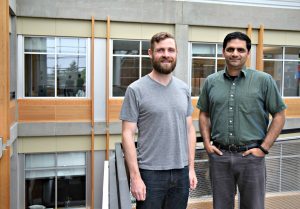
From left: Dr. Anthony Smith and Professor Visvesh Sathe
Brain computer interfaces (BCIs) offer a direct communication pathway between the brain and external technologies. BCIs are of significant research interest for their potential role in repairing human cognitive or sensory-motor functions for conditions like stroke and paralysis.
Although BCIs present great opportunities for brain to device connectivity, there are several challenges in application: next-generation BCIs require a large number of neural recording and stimulation electrodes for broad and dense coverage. Existing recording electronics techniques are unable to scale to these large counts without a prohibitive increase in silicon-die area. Further, BCIs generate large stimulation artifacts, obscuring important signals shortly after stimulation.
In an article, entitled “A Scalable, Highly-Multiplexed Delta-Encoded Digital Feedback ECoG Recording Amplifier with Common and Differential-Mode Artifact Suppression,” UW researchers present a system that addresses these challenges, increasing channel recording density by ten times current state-of-the-art systems.
“The focus of the effort was on developing architectural techniques that could be leveraged to allow us to design high-density recording electronics,” UW electrical engineering Assistant Professor and PI on the project Visvesh Sathe said. “The system allows for highly multiplexed recording channels, exploiting the inherent structure in neural signals to achieve high precision recording using simple, robust circuits. The system also suppresses, for the first time, both common-mode and differential-mode artifacts.”
The system is useful for a variety of bio-potential signal acquisition applications, offering support to researchers when signals from the human body have to be read. This process expands to numerous medical applications, including nervous system diseases like Alzheimer’s and Parkinson’s.
“This work is a first step toward a realistic Bidirectional Brain Computer Interface on a single chip,” senior author on the paper Anthony Smith (Ph.D. ’17) said. “The next step will be integrating this system with the CMOS-compatible stimulation platform that has also been developed at UW and adding on-chip computation to enable closed-loop operation.”
Additional authors on the paper include UW electrical engineering graduate student John Uehlin, UW physiology and biophysics Research Associate Steve Perlmutter and UW electrical engineering Associate Professor Chris Rudell.
The work is funded by the Center for Sensorimotor Neural Engineering (CSNE), a UW-based center established through the National Science Foundation Engineering Research Centers (NSF ERC) program.

